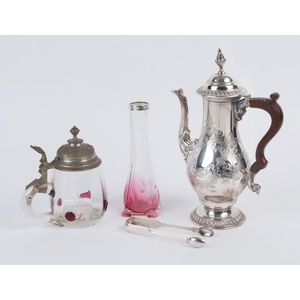Assorted Silver and Glassware Lot
Sheffield plate coffee pot, silver mounted glass vase, silver plated sugar tongs and a glass and pewter tankard, 19th and 20th century, (4 items), the coffee pot 30 cm high
You must be a subscriber, and be logged in to view price and dealer details.
Subscribe Now to view actual auction price for this item
When you subscribe, you have the option of setting the currency in which to display prices to $Au, $US, $NZ or Stg.
This item has been sold, and the description, image and price are for reference purposes only.
- Tankard - A tankard is a drinking vessel for beer, ale, and cider, similar in shape to a large mug, and usually with a hinged lid. Silver tankards were in use in Britain and other parts of Europe from at least the sixteenth century, pewter tankards probably from the thirteenth. In the 19th century a number of ornately carved ivory tankards were produced, but these were designed to demonstrate the skill of the carver, rather than for day to day use. The shapes of tankards vary, sometimes globular, sometimes a tapering concave. For those with lids, the lid usually includes a thumbpiece that the drinker can hold down to keep the lid open. Variation in the design of the thumbpiece include wedge, ball and wedge, ball, hammer head, bud and wedge, double volute (scroll), chair-back, ball and bar, shell, double acorn, corkscrew, and ram's horn.
- Sheffield Plate - Sheffield plate was the first commercially viable method of plating metal with silver. The method of plating was invented by Thomas Boulsover, a Sheffield Cutler, in 1743 and involved sandwiching an ingot of copper between two plates of silver, tightly binding it with wire, heating it in a furnace and then milling it out in to sheet, from which objects could be made.
Originally used by its inventor to make buttons, the potential of the material was quickly realised, and soon it was being used to fashion boxes, salvers and jugs, and not long after that candlesticks and coffee pots, and other traditional tableware.
Although there was a considerable saving in the amount of silver used, Old Sheffield Plate manufacture was more labour intensive than solid silver, meaning higher labour costs. This meant that Old Sheffield Plate was very much a luxury product, and only available to the very wealthy.
The thickness of the silver means that many 18th century Sheffield Plate pieces still have a good layer of silver, while electroplated pieces (EPNS), may have been replated several times over their lifetime. Where the silver has worn off the Sheffield plate the soft glow of the copper base can be seen underneath. However this is not an infallible guide that the piece is Sheffield Plate, as many EPNS items were also plated on to a copper base.
Most Sheffield plate items are unmarked, whereas most elecroplated items display manufacturers names or marks, quality indications such as "A1", "EP", together with pattern or model numbers.
Sheffield plate was made commercially between 1750 and 1850.
This item has been included into following indexes:
